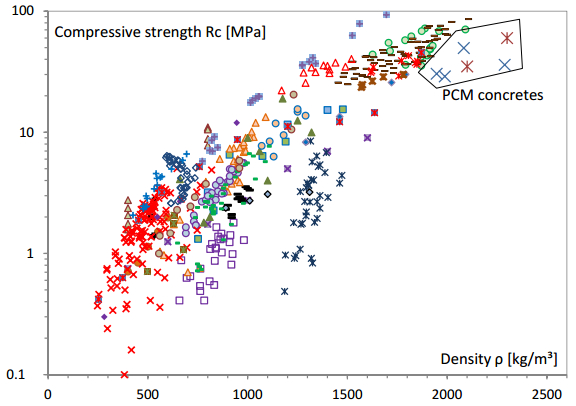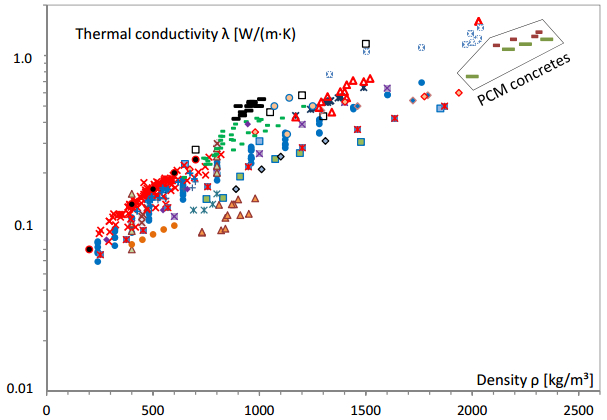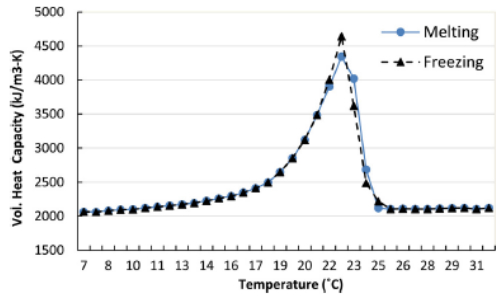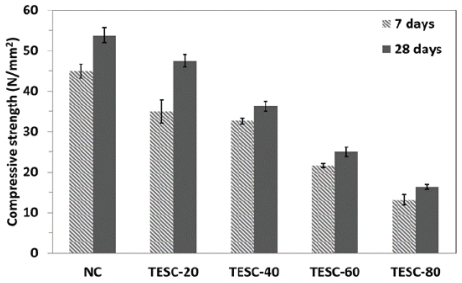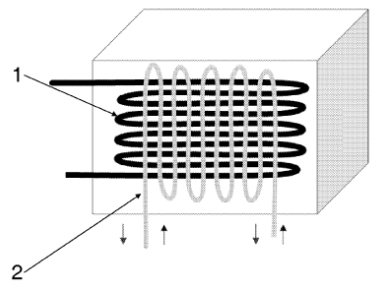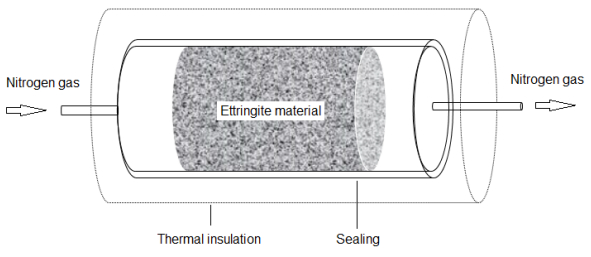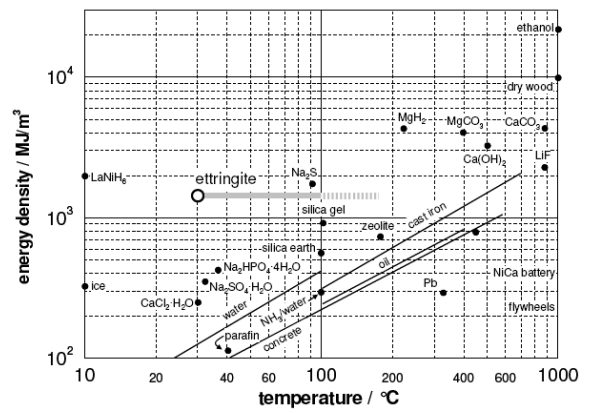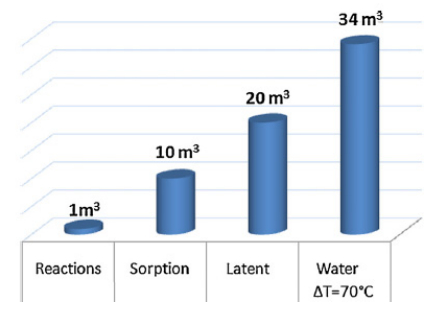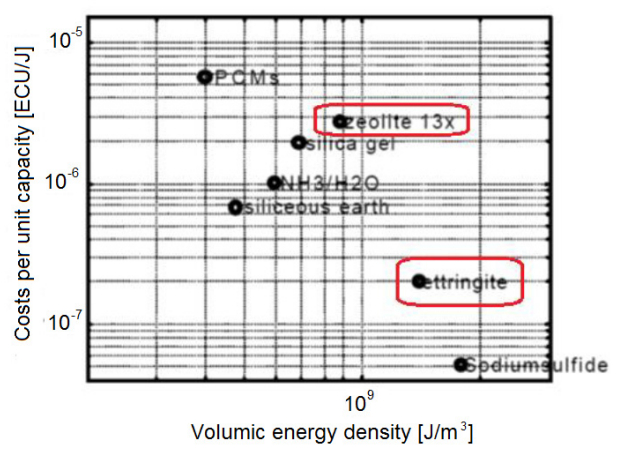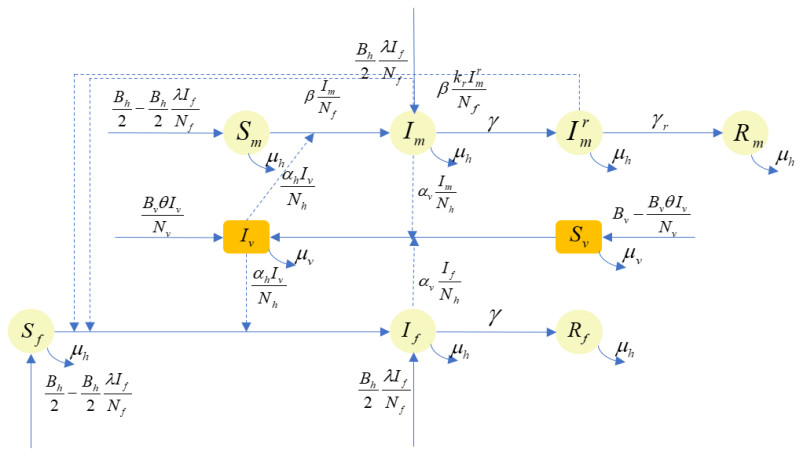1. Introduction
World energy consumption has huge environmental and socioeconomic impacts. Heat storage allows the use of renewable energy in buildings to be increased and enhances their energy storage performance. The problem of using solar energy is its intermittent character. It is clear that heat storage could avoid the phase shift between solar radiation and thermal energy demand and would increase the use of solar energy in the building sector. Many heat storage materials could be used for this purpose.
Sensible heat storage is widely used in such devices as a hot water tanks [1]. Concrete solutions for thermal energy storage are usually based on sensible heat transfer and thermal inertia [2,3,4,5,6,7] and numerous numerical studies have been performed on sensible heat storage using concrete [8,9,10,11]. Despite the prominent advantage of mechanical performance, the disadvantages of sensible heat storage by concrete are low storage density, the space required, heat loss and short duration of heat storage.
The storage density of Phase Change Materials (PCM) is higher than that of materials storing sensible heat [12,13]. Phase change materials (PCMs) and their applications in thermal energy storage have been considered by several authors [12,14,15,16]. To improve building energy performance, the incorporation of PCM in concrete walls has been investigated [15,16,17,18,19,20,21,22,23,24]. Several models have been developed to predict the heat storage performance and the thermal or mechanical properties of concrete containing phase change materials [16,25,26,27,28]. However, these materials are not suitable for long-term heat storage. A seasonal storage system requires very low heat loss between summer and winter, and high energy density to reduce its size and cost [29].
Sorption heat storage materials are extensively used in buildings [30,31,32,33,34,35,36] and the behavior of sorption heat storage materials such as zeolites has often been simulated [6,35,37,38]. The method used to improve the heat storage capacity of these materials consists in impregnating the sorption material with hygroscopic salt [39,40,41,42,43,44].
Chemical storage materials have the advantage of high storage density compared to other storage materials [13,45,46]. Thermodynamic or kinetic models have been designed to simulate chemical reactions that allow heat to be stored [47,48,49,50]. Despite their high storage density, the main problems of chemical storage materials are high storage temperature (500 ℃ for calcium hydroxide), low mechanical resistance and high investment cost. Cementitious materials (paste, mortar, concrete) with high ettringite content demonstrate high energy storage density at low temperature (around 60 ℃), they have high mechanical strength, and are relatively cheap. Thermal energy storage by ettringite material is a combination of physical (adsorption) and chemical (chemical reaction) processes usable in both the short (daily, weekly) and long (seasonal) term. In the charge phase, the heat is stored by endothermic heating (desorption and dehydration) and is not restored as long as the ettringite material is kept dry. In the discharge phase, the heat stored in the ettringite material is released by exothermic adsorption (adsorption and hydration). Figure 1 describes the types of heat storage and the concrete used as the storage material.
Struble and Brown [51] were among the first to study the storage capacity of cementitious materials such as ettringite (3CaO·Al2O3·3CaSO4·32H2O). Heat storage using ettringite-based material (non-aerated material) has also been studied [52]. To improve exchanges (permeability) between water and ettringite molecules (enhancing storage efficacy), aerated cementitious material with high ettringite content was developed by sulfoaluminate cement hydration [53,54]. A numerical model was set up to predict the spatiotemporal behavior of ettringite based material during the charging and discharging phases [55]. The durability and stability of the resulting ettringite material was investigated (thermal stability, carbonation, and reversibility) [56]. Heat storage prototypes with ettringite material have been designed and tested [54,55].
Hence, we feel it is now essential to compile and review heat storage, particularly that based on cementitious material used as a sensible, latent, thermochemical storage material. This review aims to compile the advances made in cementitious material for heat storage and the place such materials occupy among the usual storage materials used in the building sector.
2. Concrete properties
The properties of concrete vary with its density. They can be examined by adapting concrete density. Non-aerated concrete, with a high density, has good mechanical performance but low insulating capacity. Aerated concretes (lightweight concrete) are increasingly used in buildings for their insulating capacities and the economies that their light weight permits in supporting structures (foundations, walls, lower floors). There are 3 methods for pore-formation in (aerated) concrete: the air-entraining method (gas concrete) [57], the foaming method (foamed concrete) [58,59] and a combined pore forming method [59].
High mechanical strength is required if aerated concrete is to be used as structural material in a building. The method of curing influences the compressive strength [57]. To improve its mechanical performance and shrinkage, aerated concrete can be autoclaved [58,60,61,62]. The chemical reactions taking place during the autoclave process are described in [63,64]. Furthermore, the pore structure and size influence the mechanical resistance of the material [65] and are highly dependent on concrete density [57,62,66]. Samson et al. [66] have plotted the mechanical resistance of concrete according to its density, where each color corresponds to data from a reference in the literature (Figure 2). In addition, the compressive strengths and thermal conductivities of PCM-enhanced cementitious materials are provided in Figure 2 and Figure 3, respectively [67,68]. As expected, Figure 2 shows an increase in the compressive strength with increasing concrete density.
Aerated concrete is widely used as insulating material in buildings thanks to its low conductivity [69]. The cellular concretes have a very low thermal conductivity, which depends on the bulk density, the water content, and the material composition [59,7,8,9,10,11,12,13,14,15,16,17,18,19,20,21,22,23,24,25,26,27,28,29,30,31,32,33,34,35,36,37,38,39,40,41,42,43,44,45,46,47,48,49,50,51,52,53,54,55,56,57,58,59,60,61,62,63,64,65,66,67,68,69,70,71,72]. The thermal conductivity of concrete is very sensitive to its water content [73]. A 1% increase in the water content of the material leads to a 16% increase in thermal conductivity [74]. Like its thermal conductivity, the compressive strength of concrete increases with its density (Figure 3) [66].
The type, size and distribution of pores are mainly responsible for the permeability [57]. Thus, the measurement of gas permeability indirectly characterizes the pore structure of aerated concrete [75]. Water vapor transfer is explained in terms of gas permeability, although gas permeability does not change significantly according to the pore-formation method [57]. Jacobs and Mayer [76] found the water and gas permeability to be approximately the same in all the materials they tested (Table 1). In [76] it was found that gas permeability decreased with increasing water content beyond a critical water content.
Table 1. Water and gas permeability values for ACC [76].
| Bulk density (kg/m3) |
Porosity (%) |
Gas permeability [10–14 m2] |
Water permeability [10–14 m2] |
| 390 |
84.0 |
2.8 ± 1.4 |
3.0 ± 1.8 |
| 490 |
78.9 |
1.4 ± 0.4 |
1.0 ± 0.6 |
| 610 |
74.8 |
2.4 ± 1.6 |
2.0 ± 1.5 |
| 630 |
74.2 |
2.4 ± 0.3 |
2.9 ± 1.8 |
Ndiaye et al. [53,56] noted that, like the porosity (14% to 76%), the gas permeability increased greatly (by a factor of 250) between non-aerated and aerated cement paste. The gas permeability of aerated cement paste (8.8 × 10–14 m2) was very much higher than that of non-aerated cement paste (3.6 × 10–16 m2). This strong increase in permeability provided information about the inter-connectivity of the porosity created by chemical foaming. The porosity of the material must be strongly interconnected to allow the gas to circulate.
Unlike other properties, the specific heat capacity of concrete is independent of its air content. It depends on the concrete composition. Thus, the measured specific heat capacity is almost constant (around 1000 J/(kg·K)) despite variations in the concrete density (Table 2). Because of their high heat capacity, cementitious materials have been used as sensible heat storage material (0–100 ℃) [77].
Table 2. Heat capacity of autoclaved aerated concrete [78].
| Bulk density (kg/m3) |
Porosity (%) |
Specific heat capacity [J/(kg·K)] |
| 304 |
85.1 |
1080 |
| 363 |
83.7 |
1160 |
| 500 |
77.6 |
1050 |
3. Sensible storage
Storage of sensible heat is due to the increase in the material temperature without phase change. A heat source (e.g. solar heat) makes it possible to raise the material temperature by ΔT, the stored heat generated by this temperature rise being determined by the first principle of thermodynamics (Eq 1).
with E the energy stored in the material (J), m the mass of the material (kg), c the specific heat capacity of the material (J/(kg·K)) and ΔT the mean temperature rise (K or ℃).
Sensible heat storage is generally used at low temperature in a range where the material is stable; its phase change temperature must not be reached. The most widely used sensitive heat storage material is liquid water because of its high specific heat capacity: c = 4180 J/(kg·K) at 20 ℃, for a temperature range lower than 100 ℃. Water is used in daily heat storage systems commonly known as solar water heaters [1]. These systems, consisting of solar thermal panels and a water tank are becoming increasingly efficient [79]. The combination of a solar water heater and an auxiliary boiler can cover the hot water needs of a building [80]. In addition, other sensitive heat storage materials such as concrete, compact rock and soil can be used in buildings [77]. Concrete solutions for thermal energy storage are usually based on sensible heat transfer and thermal inertia [2,3,4,5,6].The cementitious material (concrete) is used to store sensible heat in a monolithic block, enhancing the energy building performance (column, wall) [8].
Compared to other, expensive ceramic materials, concrete has already demonstrated its ability to provide suitable and economically feasible thermal energy storage solutions using sensible heat [81,82,83]. Thanks to its low cost and good thermal conductivity, a concrete block with a piping network has been used in solar power plants at temperatures of up to 400 ℃ (Figure 4) [9,10,84,85].
The advantages of concrete storage systems in solar power plants are the low cost of storage media, the easy workability of the material, and the limited degradation of heat transfer between exchanger and storage medium [10]. Among the main disadvantages are cost increments for the exchanger and engineering in general, and long-term instability.
Sensitive heat storage is suitable for the short term, but for long-term storage (seasonal) a large amount of storage material (e.g. large underground hot water tank) is required, with good thermal insulation. The disadvantages of sensible heat storage in buildings are low storage density, heat loss during storage, the space required and the limited storage time.
4. Latent storage
The storage density of Phase Change Materials (PCM) is higher than that of materials storing sensible heat [12,13]. The thermal energy is stored by a change of the physical state of the material at almost constant temperature (Eq 2).
with E the amount of latent heat stored (J), m the mass of the PCM (kg), and L the specific latent heat of the PCM (J/kg).
Phase change materials (PCMs) and their applications in thermal energy storage have been investigated by many researchers [12,14,15,16]. To improve building energy performance, the focus has often been on PCM incorporated in concrete walls [15,16,17,18,19,20,21,22,23,24]. Basically, three different ways to use PCMs for heating and cooling of buildings are [86]: (ⅰ) PCMs in building walls, (ⅱ) PCMs in building components other than walls, and (ⅲ) PCMs in hot and cold storage units. The incorporation of PCM into different sections of buildings, such as wallboards, floor and Trombe wall, has shown promise in applications for heating or cooling systems in buildings [15]. It improves the thermal inertia of the building, thus avoiding sudden changes in the indoor temperature [87].
Figure 5 shows the heat storage capacity of self-compacting concrete with 13.5% PCM by volume [67]. The heat storage capacity of PCM concrete tile (10.6 J/g) has been observed to be significantly better than those of traditional concrete tile. It was found that the addition of 13.5% PCM per volume of concrete tile increased the heat storage capability by 35% while maintaining acceptable compressive strength (28.4 MPa) [67]. This indicated that the 3.8-cm-thick tile of PCM-enhanced concrete had a thermal mass equivalent to that of a 5.9-cm-thick tile of regular concrete. The use of PCM-enhanced concrete floor tile greatly improved the building's thermal inertia (especially in a lightweight building).
Cement based thermal energy storage composites (TESC) were developed by including PCM (paraffin) in ordinary cement mortar [88]. TESC based on Portland cement with 20%, 40%, 60%, and 80% of PCM was tested; the results showed significantly enhance thermal performance with increasing levels of PCM in the composite [88]. The energy storage capacity of the ordinary cement mortar was greatly increased (from 47 to 125 J/g) when the replacement ratio was 80%. However, including PCM in cementitious materials had the disadvantage of leading to a drop in mechanical performance [86,89]; a reduction in compressive strength was observed with increasing levels of PCM in the composite (Figure 6).
The depletion of non-renewable energies and rising energy prices have driven the emergence of European Union directives designed to increase energy efficiency by 20% before 2020. Energy retrofitting is now essential to reduce the high energy consumption in existing buildings [90] and PCM concrete tile is a valuable option this field. Furthermore, the application of PCM wallboards to surfaces in building retrofitting have been shown to improve the thermal comfort [91]. The use of PCM wallboards in the retrofitting of typical office buildings in five European cities led to a significant decrease of cooling energy demands in each city [92]. A composite PCM system (panels) consisting of two commercial PCMs with different melting temperatures (21.7 ℃ and 25 ℃) was investigated for the energy retrofit of high-rise apartments (high, transparent facades) in Toronto [90]. The application of composite PCM to the walls and ceiling of 1:10 scale test cells representing a typical apartment reduced temperature fluctuations (6 ℃) in both the cooling and heating seasons.
The incorporation of PCM into cementitious matrix material improved its heat storage capacity and the thermal inertia of the building. However, some disadvantages of PCMs constrain their use in the building sector: low phase change enthalpy, limited storage time, mechanical effect on cementitious material, volume instability, and (in some cases) flammability of the PCM.
5. Sorption storage and chemical storage
Sorption storage and chemical storage are carried out by physisorption (desorption -adsorption) and chemical heat storage (dehydration -hydration), respectively [93]. These two types of energy storage have the advantage of having a higher storage density than sensible heat storage or latent heat storage.
Sorption storage consists of storing heat by using it to break the bond between water molecules and the material. The breaking of this physical bond is an endothermic reaction (endothermic desorption) [13,94]. Heating the material for sorption storage leads to endothermic desorption of the water molecules. This is the charging phase. The heat stored in the material is released during the exothermic adsorption of water molecules in the discharge phase [13]. Akgun [95] classifies sorption storage materials as organic, inorganic or hybrid. The characteristics of sorption storage materials (in the form of a powder bed) such as zeolites, activated carbons and silica gels have been widely studied in the literature [34,95,96]. Many experimental or numerical studies have been performed on zeolites [31,32,33,34,35]. These sorption storage materials are suitable for seasonal heat storage in buildings. Nevertheless, their storage density is lower than that of chemical storage materials.
As the name implies, chemical storage is related to a chemical reaction (Eq 3). In the charging phase, the material (A) is heated (for example by solar energy) until chemical decomposition breaks it down into two stable elements (B) and (C) [13,44,97]. The stored heat is restored during the exothermic chemical reaction of (B) and (C). The chemical storage device requires separate tanks containing the reaction products [13]. The reversible chemical reaction allows heat to be charged and discharged according to Eq 3.
Ettringite (3CaO·Al2O3·3CaSO4·32H2O) is a common hydrate found in cement-based materials and it has the advantage of high energy storage density at low temperature (around 60 ℃) [51]. Portland cements used in most construction materials produce a few percent of ettringite, but calcium sulfoaluminate cements (CSA) can produce much larger amounts of this compound (40–80%) with fairly rapid kinetics [53,56]. Thermal energy storage by ettringite material is a physicochemical process usable in both the short term (day, week) and long term (season). The physical process is related to water vapor desorption-adsorption on ettringite molecules. The connection between ettringite and free water molecules is physical bonding related to the weak intermolecular forces (Van der Waals forces) and hydrogen bonding [56]. The chemical heat storage process is based on the reversible ettringite-metaettringite conversion (dehydration-hydration process) according to Eq 4 [55,56]. In the charge phase, the heat is stored by endothermic heating (desorption and dehydration) and is not restored as long as the material is dry. In the discharge phase, the heat stored in the material is released by exothermic adsorption (adsorption and hydration) [54]. The enthalpy of dehydration allows the amount of heat energy stored chemically to be determined.
|
Ettringite(30H2O)+Heat↔Metaettringite(12H2O)+Water(18H2O)
|
(4)
|
Struble and Brown [51] were among the first to study the storage capacity of pure ettringite. They produced pure ettringite by chemical synthesis from pure minerals, thus satisfying the high AFt content criterion. However, this method led to ettringite precipitation in the form of powder, whereas monolithic storage material is required for mechanical strength. Several types of substituted ettringitewere chemically synthetized with stoichiometric proportions of raw materials [51]. The precipitated salts were investigated using TGA and DSC (Table 3).
Table 3. Dehydration data for substituted ettringite phases [51].
| Phase |
Loss (mol H2O per mole phase) |
Enthalpy change (J/g phase) |
| [Ca3Al(OH)6]2(SO4)3·26H2O |
19 |
600 |
| [Ca3Fe(OH)6]2(SO4)3·26H2O |
24 |
800 |
| [Ca3Al(OH)6]2(CO3)3·26H2O |
23 |
800 |
| [Ca3Si(OH)6]2(SO4)2(CO3)2·24H2O |
9 |
300 |
The high dehydration enthalpy of these ettringite phases and the reversibility of the reaction proved their heat storage capacity (Table 3). However, additional studies were necessary to design and produce a prototype with ettringite based cementitious material as a proof of concept.
5.1. Non-aerated ettringite material
A heat storage reactor with sulfoaluminate cement based material was tested by Winnefeld and Kaufmann [52,98]. The reactor [98] consisted of ettringite material (18 × 40 × 50 cm) cast on a piping network which allowed heat to be charged (heating) into and discharged (hydration) from the material (Figure 7). During the charging phase, a hot fluid circulated in the horizontal sealed piping network (No.1, Figure 7) generating endothermic dehydration of the material around the tube; the heat was thus stored. The heat discharging phase was controlled by the vertical perforated piping network (No.2, Figure 7) where liquid water circulated and hydrated the material, the stored heat being restored by exothermic rehydration. Liquid water rather than vapor was used to hydrate the material, so only chemical heat was stored.
To test the heat storage system at building scale, a full scale prototype project was built to cover the heat needs of a single-family house located in Seelisberg (Switzerland) by seasonal heat storage [99]. The large scale prototype consisted of 6 m3 of sulfoaluminate based material with a copper piping system, which was installed in the garage of the house to store and discharge solar heat. The storage device consisted of 24 separate, 400 kg blocks connected by copper pipe. The ettringite material was sealed off from the surrounding environment by a metal case. The house was equipped with 20 m2 of solar panels heating a water tank (9 m3) to 85 ℃. This sensible storage made it possible to store solar energy from the collector and provided the amount of heat needed to keep the house comfortable until the end of December. The prototype with ettringite material was intended to avoid the heat gap during two months (January and February) [99]. This prototype was connected to the central heating system by a network of pipes connecting the solar panels, water tank, and heat exchanger. The solar panels made it possible to heat the 6 m3 of ettringite material to 80 ℃ during the summer by the circulation of heat transfer fluid (water) in a copper tube. This heating led to endothermic dehydration of the storage material (charging phase). Then the heat was restored in winter by hydration (exothermic reaction) using liquid water (discharging phase). The cold water inside the tubes was heated by the restored heat and transported to the house. However, the use of cementitious material as a thermochemical storage material in the building sector is hampered by problems of durability (carbonation, thermal stability) and material structure [55,56]:
Sustainability: the main problem of using the material is the chemical stability of ettringite molecules over time in the presence of carbon dioxide (CO2) [56], which, when there is moisture in the cementitious matrix, may cause carbonation leading to the decomposition of hydrated phases. Grounds et al. [100], Nishikawa et al. [101] and Chen and Zou [102] confirmed the sensitivity of ettringite to atmospheric CO2. This showed that the use of ettringite material as heat storage material required it to be protected against CO2. So an open-loop heat storage prototype in air was not adequate. To overcome this stability problem, a prototype using moist nitrogen instead of moist air to humidify the ettringite material in the discharging phase was designed to avoid ettringite carbonation [54,55].
Material: the ettringite material based on sulfoaluminate cement has low porosity and low permeability [103], which is not favorable for water vapor transfer through the material porous network [56]. During the charging phase, it is necessary for the desorbed water vapor to move easily through porosity from the inside to the outside of the reactor to achieve complete dehydration (fully dry material). Similarly, water vapor from outside should move easily through the porosity to fully hydrate the material (saturated material). Partial hydration (or partial dehydration) leads to incomplete heat release (or to incomplete charging of heat). So to optimize the storage efficiency, it is important to enhance the permeability, thus favoring water transfer in the material porosity. To overcome this structural problem and improve the heat storage capacity of the material, its porosity and permeability must be increased [53].
5.2. Aerated ettringite material
The aerated ettringite material for heat storage was developed in the laboratory [53,54,56], where the hydration of sulfoaluminate binders was followed by X-ray diffraction (XRD), thermogravimetric analysis (TGA) and scanning electron microscopy (SEM) [53]. This was completed by thermodynamic modeling to predict the chemical evolution of the material during hydration (ettringite content) [53]. The resulting material had a high ettringite content (68%) and dimensional stability. However, this material had a high density, which reduced the accessibility of water molecules to that of AFt. In order to use the ettringite material as heat storage material, it was necessary to improve its permeability, thus enhancing the diffusion of water vapor in the material and the exchanges between water and AFt molecules [56]. The ettringite system based on sulfoaluminate binder (CSA clinker and anhydrite) was aerated by addition of aluminum powder and calcium hydroxide (Ca(OH)2), the reaction of the latter (foaming process) releasing hydrogen gas which increased the volume of the paste and generated porosity [53,54] (Figure 8).
The heat storage capacity of this improved material was tested using the closed loop heat storage prototype under nitrogen gas. A model based on the energy and mass balance in the cementitious material was developed and simulated in MatLab software, and was able to predict the spatiotemporal behavior of the storage system [55]. This enabled a first thermochemical reactor prototype to be built for heat storage tests in both the charging and discharging phases. This first reactor was a cylindrical adsorber (d = 11 cm, l = 13 cm) equipped with an axial copper pipe (d = 1 cm) [55]. Thus experimental tests validated the numerical model and served as proof of concept. Nevertheless the amount of stored heat released in the discharging phase was only 61 kWh/m3 instead of the theoretical maximum of 138 kWh/m3 (or a heat storage yield of 44%). To enhance the storage yield, a second prototype (without the metal tube) where a single gas (nitrogen) in direct contact with the ettringite material porosity served as the heat transfer fluid in the charging phase and as the humidifying gas in the discharging phase.
To perform the storage tests in the laboratory, the reactor was connected to a heater and a humidifier to simulate heat charging and discharging, respectively. The heater was only used during the charging phase and the humidifier only hydrated the material during the discharging phase. The {reactor + heat source + source of moisture} set formed the heat storage system. The test bed installed in the laboratory reproduced the functioning of the system. The reactor (second prototype) was a cylindrical thermochemical adsorber, 16 cm in diameter and 32 cm long, with no piping network. It consisted of ettringite material insulated from steam or water by a PVC cylinder (Figure 9). To avoid heat loss, the reactor was thermally insulated from its surroundings by a 10 cm thick layer of glass wool and a thin layer of polystyrene at the surface.
During the heat charging phase, the electric heating system was used to heat the dry nitrogen as in a solar collector and the resulting hot gas (60 ℃) passed through the porosity of the material [54]. The dehydration of the material led to the heat storage. This period lasted for about 3 days for this prototype size (4.4 l, 1.8 kg). The heat stored was not restored as long as the ettringite material was isolated from water (vapor or liquid). Unlike in sensitive or latent storage systems, thermal insulation of the ettringite material was not required during the intermediate phase between charging and discharging. Heat storage could be short-term (for days or weeks) or long-term (seasonal) [55]. The chemical part of the storage process (endothermic dehydration) was related to the conversion of ettringite to metaettringite by the loss of 18 molecules of water per molecule of ettringite (Eq 4).
In the discharging phase, a humidification system consisting of a water bubbler was used to charge the gas (nitrogen) circulating through it with water vapor. This humidified gas passed through the permeable porous material, which adsorbed water vapor (physical reaction) and then hydrated (chemical reaction). This generated an exothermic reaction (Eq 4) and the restored heat was transported by the heat transfer fluid (nitrogen). During this phase of heat recovery, the cold, humidified gas (inlet nitrogen) became hot and dry (outlet nitrogen). The reversibility of the ettringite material reaction was proved by physicochemical investigations over several heat storage cycles [51,56]. The heat storage yield, the ratio of discharged heat to charged heat, was 71%, with a storage density of 117 kWh/m3. The prototype was not only simpler in terms of operation, but also more efficient in terms of heat storage performance than other thermochemical prototypes using hydrate salts [29].
5.3. Advantages of ettringite material compared to other storage materials
In addition to the high potential storage density, there are several advantages of using ettringite material for heat storage:
Low storage temperature (around 60 ℃): Portlandite (Ca(OH)2), identified in Figure 10, is a hydrate phase found in cementitious material capable of storing high amounts of heat (chemical), but with a high storage temperature (500 ℃). Zeolites, one of the most commonly used sorption storage materials, store heat at about 200 ℃. Indeed, the disadvantage of this type of material (chemical storage and sorption storage) is its high storage temperature, difficult to achieve with a conventional solar collector. The advantage of ettringite is its high storage density at low temperature (about 60 ℃). This temperature range (around 60 ℃) is easily reached using a conventional solar collector and is suitable for heating systems, or controlled mechanical ventilation, especially for low-energy buildings [104].
Space requirement: Figure 11 compares the volume of material necessary to store 6.7 MJ according to the type of storage [45]. Sensitive heat storage (water for example) requires the highest material volume due to its low storage capacity. Phase change materials (PCM), with higher storage density, require less volume. The figure shows that chemical reaction storage systems, are much less cumbersome than those using sensitive or latent storage. Thus the space issue, which has been holding back the use of heat storage materials in buildings, could be avoided with this cementitious material.
Investment cost: The running cost and the cost of insulation increase with the volume of storage material. Therefore, volume appears to be the most important criterion for the economic evaluation of the storage system. Investment, operation, maintenance and recycling costs must all be taken into account in the economic evaluation of a storage system [105]. Van Berkel [105] made a comparison of energy prices for several heat storage materials (Figure 12). This confirmed the advantage of ettringite material in terms of investment cost in comparison with phase change materials and sorption storage materials (e.g., zeolites). Ettringite, with its higher storage density, has a unit price 10 times lower than that of zeolites (Figure 12).
Thermal insulation during intermediate storage phase: The heat storage cycle consists of 3 phases (charging, intermediate, and discharging phases). The intermediate phase between charging and discharging generally lasts the longest—several months for seasonal storage. One of the key problems of seasonal heat storage is to ensure thermal insulation during this long period. In the case of cementitious material (ettringite), thermal insulation is not necessary during this intermediate phase as the heat from chemical sorption is not restored as long as the material remains isolated from water (liquid or vapor). This may argue in favor of the use of this cementitious material as a seasonal storage material. However, the charging and discharging phases require thermal insulation.
Short-and long-term heat storage: Sensible storage or latent storage is not suitable for long-term storage. In addition to the large volume of material required (low storage density), the problem of thermal insulation is a major handicap for this type of storage. By combining physisorption and chemisorption, ettringite material has the advantage of being appropriate for both short-term (daily) and long-term (seasonal) storage.
Mechanical resistance: Most heat storage materials come in the form of a powder bed (zeolite, magnesium sulfate), whereas the cementitious material is in monolithic form with mechanical resistance (cement paste, mortar or concrete). Ettringite binders have been widely used in building construction thanks to their high mechanical resistance [106,107].The monolithic form of the storage material and its mechanical strength would enable it to be easily integrated in buildings as walls or bricks storing heat. Depending on the mechanical requirements of the construction, the storage material can be used as a self-supporting structure or even a supporting structure if its mechanical strength is sufficient.
5.4. Building applications of heat storage by ettringite
Heat storage with ettringite material shows promise for heating system applications in the building and industrial sectors [54]. Thermochemical reactors with ettringite material can be integrated in any system where low temperature heat storage is needed to increase the use of renewable energy (heating systems, ventilation, etc.).
Self-supporting wall storing solar heat: The monolithic form of the storage material and its mechanical strength enable it to be easily integrated in buildings as walls or bricks storing heat. Depending on the mechanical requirements of the construction, the storage material can be used as a self-supporting structure or even a supporting structure if its mechanical strength is sufficient. During the charging phase, a hot fluid from the thermal collector circulates in the porosity network of the aerated wall, generating endothermic dehydration and thus heat storage. On the other hand, the heat discharging phase is controlled by a humidification system where water vapor circulates and hydrates the material, the stored heat being restored by exothermic rehydration. The resulting hot gas in a closed circuit could be used via a heat exchanger to heat ambient air in the building. This allows the thermal inertia of the building to be improved, thus avoiding sudden changes in the indoor temperature. This type of application is hence confirmed as a valuable option in lightweight buildings, where thermal inertia is generally low.
Solar storage box: This consists of a cylindrical thermochemical reactor with ettringite material connected to humidifier device. This box, installed in building and connected to solar panels, enables renewable solar heat to be stored. The automatic humidifier can release heat to maintain thermal comfort in the building. The solar storage box can thus solve the problems related to solar heat intermittency, thereby increasing the use of renewable energy in the building sector. This type of box can be combined with an auxiliary boiler using an electronic regulator to meet household energy needs (heating or hot water).
6. Conclusion
Cementitious materials have been considered purely for their mechanical performance for too long. Nowadays, the heat storage capacity of concrete is attracting great interest. This paper summarizes the investigation and analysis of available thermal energy storage systems with cementitious materials for use in different applications and gives an overview and comparison of advances in cementitious materials and their place among the usual storage materials. It should be noted that the properties of concrete depend greatly on its density.
Thanks to its high heat capacity and mechanical performance, concrete allows sensible heat from solar collectors to be stored in a building in the short term by using concrete modules, walls, or floors with piping networks. The use of a concrete block with a piping network at larger scale in a concentrated solar power plant has shown encouraging results. Research works are still needed to find suitable hydrothermal conditions ensuring sufficient energy density, stability and cyclability, and acceptable compressive strength of the concrete.
The incorporation of PCM in different sections of a building, such as walls and floors, has promising applications for heating or cooling systems. It improves the thermal inertia of the building, thus avoiding sudden changes in the indoor temperature. The use of PCM is suitable for lightweight buildings where building inertia is low. Tile or wallboards with PCM-enhanced concrete are a valuable option in building retrofitting to decrease energy demands. However, the incorporation of PCM in cementitious materials leads to a drop in mechanical performance. In building applications, it is necessary to find a compromise that optimizes energy density, mechanical performance and durability of PCM-enhanced concrete.
Sensible and latent cementitious materials are capable of storing heat but only in the short term (day, week). Experiments with prototypes show that cementitious material with high ettringite content can store heat by physicochemical process usable in both the short term (days or weeks) and long term (season). The main advantages of ettringite material are high energy storage density at moderate temperature (around 60 ℃), high mechanical strength, and low price. Thermochemical reactors with ettringite material can be integrated in any system where low temperature storage heat is needed to increase the use of renewable energy in the building sector. However, the use of cementitious material in buildings is hampered by problems of durability: thermal stability, reversibility, mechanical stability and volume stability. The durability criterion must not be neglected when choosing a heat storage material, particularly in buildings where mechanical strength is required (supporting structure). The seasonal cyclability remains to be investigated in a building-scale prototype.
Conflict of interest
All authors declare no conflict of interest in this paper.









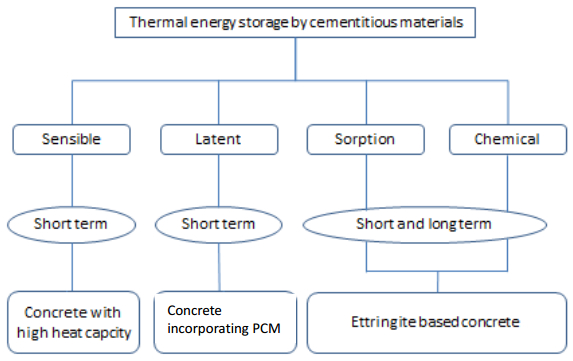
 DownLoad:
DownLoad: 